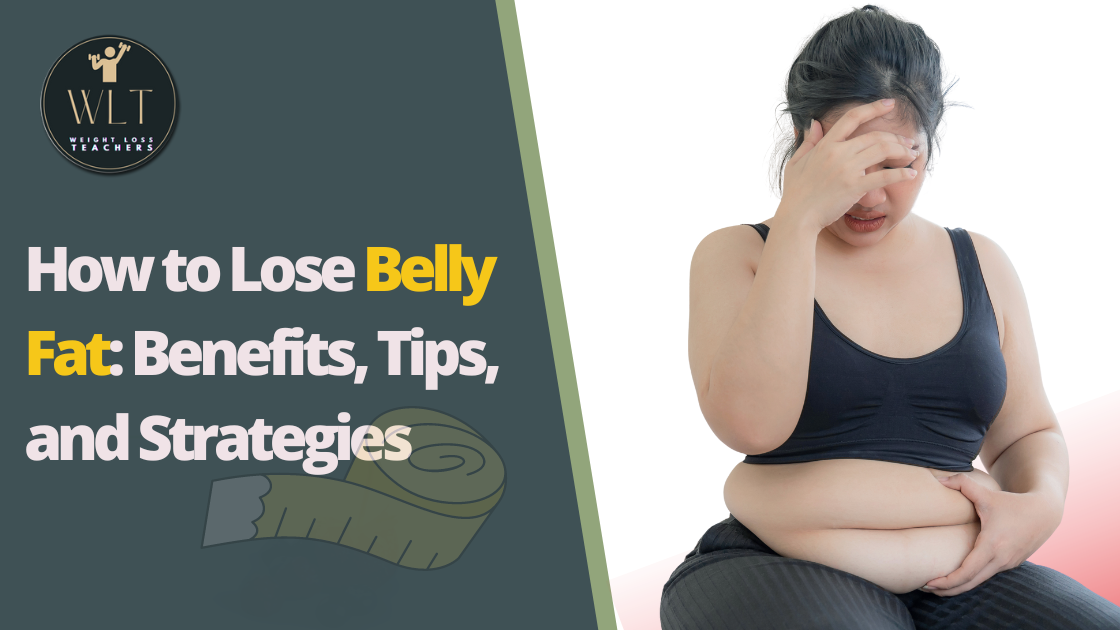
How to Lose Belly Fat: Benefits, Tips, and Strategies
Excess belly fat is not only a cosmetic concern but also a serious health issue that can lead to various chronic conditions. Many people struggle to shed those stubborn pounds around their midsection. While spot reduction is not feasible, losing belly fat requires a holistic approach combining proper nutrition, regular exercise, and lifestyle modifications.
Struggling with stubborn belly fat? You’re not alone. Belly fat is not only unsightly but can also pose significant health risks. Fortunately, effective strategies exist to tackle this problem head-on. Discover the benefits of losing belly fat, from improved heart health to enhanced confidence. Learn essential tips and proven strategies to help you achieve a flatter stomach. Whether it’s dietary adjustments, targeted exercises, or lifestyle changes, we’ve got you covered on your journey to a healthier, trimmer waistline.
Table of Contents
Understanding Belly Fat

The Types of Belly Fat
- Subcutaneous Fat: Subcutaneous fat is the soft, pinchable layer of fat found just beneath the skin. It is the type of fat that gives your belly a flabby appearance when you pinch it. While subcutaneous fat is not as harmful as visceral fat, excess accumulation can still contribute to overall weight gain and health issues.
- Visceral Fat: Visceral fat, on the other hand, is the more dangerous type of belly fat that accumulates around internal organs. It forms a “beer belly” or “potbelly” appearance and is associated with increased risks of heart disease, type 2 diabetes, and other metabolic disorders. This fat releases inflammatory substances and hormones that can disrupt the body’s balance and lead to various health complications.
The Health Risks Associated with Belly Fat
- Cardiovascular Diseases: Visceral fat actively contributes to the development of cardiovascular diseases, including heart attacks and strokes. The inflammatory substances released by this fat type can damage blood vessels, increase blood pressure, and elevate cholesterol levels, promoting the formation of arterial plaques.
- Type 2 Diabetes: Belly fat is closely linked to insulin resistance, a condition where the body’s cells become less responsive to insulin, leading to elevated blood sugar levels. Persistent high blood sugar levels can eventually result in the development of type 2 diabetes.
- Insulin Resistance: As belly fat releases free fatty acids and inflammatory substances, it interferes with insulin signaling and promotes insulin resistance. This condition disrupts glucose regulation and increases the risk of developing diabetes.
- High Blood Pressure: Visceral fat contributes to high blood pressure by releasing hormones that affect the kidneys’ sodium balance and constrict blood vessels. Elevated blood pressure is a major risk factor for heart disease and stroke.
- Metabolic Syndrome: Metabolic syndrome is a cluster of conditions, including high blood pressure, high blood sugar, abnormal cholesterol levels, and excess belly fat. Together, these factors significantly increase the risk of developing cardiovascular diseases and type 2 diabetes.
- Certain Cancers: Studies have shown a strong correlation between excess belly fat and an increased risk of various cancers, such as breast cancer, colorectal cancer, and pancreatic cancer. The exact mechanisms behind this association are still being researched, but it underscores the importance of maintaining a healthy waistline.
Benefits of Losing Belly Fat

Improved Heart Health
- Reduced Risk of Heart Diseases: Losing belly fat, particularly visceral fat, helps alleviate the strain on the cardiovascular system. By reducing inflammation and improving insulin sensitivity, you can lower the risk of heart diseases, such as heart attacks and strokes.
- Lowered Blood Pressure and Cholesterol Levels: Shedding excess belly fat can lead to significant reductions in blood pressure and cholesterol levels. This, in turn, decreases the risk of atherosclerosis (hardening of the arteries) and lowers the likelihood of developing heart-related problems.
Enhanced Metabolic Health
- Better Insulin Sensitivity: By losing belly fat, insulin sensitivity improves, allowing cells to respond better to insulin. This helps regulate blood sugar levels and decreases the likelihood of developing insulin resistance and type 2 diabetes.
- Decreased Risk of Type 2 Diabetes: Lowering visceral fat levels reduces the risk of type 2 diabetes. Improved glucose regulation contributes to better overall metabolic health, preventing the onset of this potentially life-altering condition.
Increased Energy Levels
- Improved Physical Performance: Carrying excess belly fat can weigh you down and impede physical activities. By shedding this weight, you’ll experience increased agility, making it easier to engage in exercises and daily activities.
- Enhanced Endurance and Stamina: As you lose belly fat and improve your overall fitness, you’ll notice increased endurance and stamina. Tasks that once left you breathless will become more manageable, enabling you to enjoy a more active lifestyle.
Boosted Self-Confidence
- Positive Body Image: Achieving a trimmer waistline can have a profound impact on your body image. Feeling good about your appearance boosts self-esteem and promotes a positive outlook on life.
- Increased Self-Esteem: Losing belly fat through dedicated efforts can provide a sense of accomplishment, elevating self-esteem and self-worth. This newfound confidence often extends to various aspects of life, positively influencing personal relationships and professional endeavors.
Essential Tips for Losing Belly Fat

Adopting a Balanced Diet
- Emphasizing Whole Foods and Reducing Processed Foods: Focus on a diet rich in whole foods, such as fruits, vegetables, whole grains, lean proteins, and healthy fats. Limit or avoid processed foods high in added sugars, unhealthy fats, and empty calories, as they can contribute to weight gain and hinder fat loss.
- Increasing Fiber Intake: High-fiber foods help you feel full for longer, preventing overeating and aiding in weight management. Opt for fiber-rich foods like legumes, nuts, seeds, whole grains, and plenty of fruits and vegetables.
- Incorporating Healthy Fats: Include sources of healthy fats in your diet, such as avocados, olive oil, nuts, and fatty fish. These fats not only promote satiety but also offer numerous health benefits, including supporting heart health.
- Watching Portion Sizes: Even healthy foods can lead to weight gain if consumed in excessive amounts. Be mindful of portion sizes and practice portion control to maintain a balanced calorie intake.
Staying Hydrated
- Benefits of Drinking Enough Water: Drinking an adequate amount of water is crucial for overall health and well-being. Water helps regulate body temperature, aids in digestion, and supports proper organ function.
- Limiting Sugary Beverages: High-sugar drinks, such as soda, fruit juices, and sweetened teas, contribute to belly fat accumulation and increased calorie intake. Opt for water, herbal teas, or infused water with fresh fruits for flavor instead.
Regular Exercise Routine
- Importance of Cardio Exercises: Incorporate cardiovascular exercises like brisk walking, jogging, cycling, or swimming into your routine. Cardiovascular workouts burn calories and fat, helping you achieve a caloric deficit necessary for fat loss.
- The Effectiveness of Strength Training: Strength training is essential for building lean muscle mass. More muscle increases your resting metabolic rate, leading to a higher calorie burn even at rest.
- Incorporating Core-Strengthening Exercises: Targeting the core muscles through exercises like planks, crunches, and leg raises can help strengthen and tone the abdominal muscles, giving your midsection a more defined look.
- Incorporating Flexibility Exercises (e.g., Yoga, Pilates): Yoga and Pilates enhance flexibility, improve posture, and reduce stress. These exercises complement cardiovascular and strength training workouts, promoting overall well-being.
Managing Stress
- Stress and Its Impact on Belly Fat: Chronic stress triggers the release of cortisol, a stress hormone linked to increased belly fat storage. Managing stress is vital for weight management and overall health.
- Techniques for Stress Reduction: Practice stress-reduction techniques, such as meditation, deep breathing exercises, mindfulness, engaging in hobbies, spending time in nature, or seeking support from friends and loved ones.
Prioritizing Sleep
- The Link Between Sleep and Weight Management: Inadequate sleep disrupts the body’s hormonal balance, leading to increased hunger, cravings for unhealthy foods, and impaired metabolism. Aim for 7-9 hours of quality sleep each night.
- Establishing a Consistent Sleep Schedule: Stick to a regular sleep routine by going to bed and waking up at the same time each day, even on weekends. Creating a calming bedtime ritual can improve sleep quality.
Effective Strategies to Lose Belly Fat

High-Intensity Interval Training (HIIT)
- Explaining HIIT and Its Benefits: HIIT involves short bursts of intense exercise followed by brief recovery periods. This type of training can burn a significant amount of calories in a short time and boost metabolism for hours after the workout.
- Sample HIIT Workouts: Perform exercises like jumping jacks, burpees, sprints, or kettlebell swings in intervals of 30 seconds to 1 minute, followed by 15-30 seconds of rest. Repeat the cycle for 15-20 minutes.
Intermittent Fasting
Intermittent fasting (IF) has gained significant popularity as a powerful tool for losing belly fat and promoting overall weight loss.
fat lose timt table
Here’s a detailed timetable for a fat loss plan that includes a balanced diet and exercise routine. This plan should be used as a general guide and customized to fit individual needs and preferences. Always consult with a healthcare provider before starting any new diet or exercise regimen.
Fat Loss Timetable
| Time | Activity | Details |
|---|---|---|
| 6:00 AM | Wake Up and Hydrate | Drink a glass of water with lemon to kickstart metabolism. |
| 6:30 AM | Morning Exercise | 30-45 minutes of cardio (running, cycling, brisk walking) or HIIT (High-Intensity Interval Training). |
| 7:30 AM | Breakfast | High-protein meal (e.g., scrambled eggs with spinach, Greek yogurt with berries, protein smoothie). |
| 10:00 AM | Mid-Morning Snack | Light snack (e.g., handful of nuts, apple slices with almond butter, cottage cheese). |
| 12:30 PM | Lunch | Balanced meal with lean protein, vegetables, and whole grains (e.g., grilled chicken salad, quinoa bowl). |
| 3:00 PM | Afternoon Snack | Healthy snack (e.g., carrot sticks with hummus, Greek yogurt, a small fruit). |
| 5:30 PM | Evening Exercise | 30-45 minutes of strength training (bodyweight exercises, weights, resistance bands). |
| 7:00 PM | Dinner | Light meal with lean protein, vegetables, and healthy fats (e.g., baked salmon with steamed broccoli). |
| 9:00 PM | Evening Snack | Light snack (if needed) (e.g., a small bowl of berries, a piece of dark chocolate). |
| 9:30 PM | Relaxation | Engage in a relaxing activity (e.g., reading, meditation, stretching) to unwind before bed. |
| 10:00 PM | Sleep | Aim for 7-9 hours of quality sleep to support recovery and fat loss. |
This eating pattern involves cycling between periods of eating and fasting. There are various IF approaches, but the most common ones include the 16/8 method (fasting for 16 hours and eating within an 8-hour window) and the 5:2 method (eating normally for five days and restricting calorie intake for two non-consecutive days).
IF helps with belly fat reduction by promoting a caloric deficit and increasing the body’s ability to burn stored fat for energy during fasting periods. During fasting, insulin levels drop, which facilitates fat burning and improves insulin sensitivity, contributing to overall metabolic health.
Intermittent fasting also supports the secretion of growth hormone, which aids in preserving lean muscle mass and further enhancing fat burning, particularly in the abdominal region.
Additionally, IF can be beneficial for reducing visceral fat, the harmful fat that surrounds internal organs. Studies have shown that intermittent fasting leads to a significant decrease in visceral fat, reducing the risk of obesity-related health issues such as heart disease, type 2 diabetes, and metabolic syndrome.
As with any dietary approach, individual results may vary, and it’s essential to adopt a sustainable IF plan that fits your lifestyle and health needs. Combining intermittent fasting with a balanced diet, regular exercise, and healthy lifestyle habits can optimize its effectiveness in losing belly fat and improving overall well-being. Consulting with a healthcare professional or registered dietitian before starting intermittent fasting is recommended, especially for those with pre-existing health conditions.
Low Carb Diet
A low-carb diet is a popular and effective approach for losing belly fat and achieving weight loss goals. The diet focuses on reducing the intake of carbohydrates, especially refined and processed carbs like sugars and white flour, while increasing the consumption of proteins and healthy fats. By minimizing carb intake, the body is encouraged to use stored fat as an alternative energy source, a metabolic state known as ketosis.
One of the primary benefits of a low-carb diet is its ability to target visceral fat, the dangerous fat that accumulates around internal organs and contributes to numerous health risks. As insulin levels decrease due to reduced carb consumption, the body is less likely to store excess fat, especially around the abdominal area.
Low-carb diets are known to suppress appetite and reduce overall calorie intake naturally. This helps individuals feel fuller for longer periods, making it easier to adhere to the diet and maintain a caloric deficit necessary for weight loss.
It’s essential to prioritize whole, nutrient-dense foods while following a low-carb diet. Incorporate plenty of vegetables, lean proteins, healthy fats, and nuts and seeds into your meals. As with any diet, it’s crucial to consult with a healthcare professional or registered dietitian before starting a low-carb diet, especially if you have any underlying health conditions or concerns. By combining a low-carb diet with regular exercise and other healthy lifestyle habits, you can optimize your chances of losing belly fat and improving your overall health.
Low Calorie Diet
A low-calorie diet is a popular and effective method for losing belly fat and achieving weight loss goals. The core principle of this approach is to consume fewer calories than your body expends, creating a caloric deficit that leads to fat loss. By reducing overall calorie intake, the body starts to use stored fat for energy, including the fat accumulated around the belly area.
A successful low-calorie diet requires careful meal planning and portion control to ensure that you still obtain essential nutrients while keeping calories in check. Emphasize nutrient-dense foods like fruits, vegetables, lean proteins, and whole grains, which provide essential vitamins, minerals, and fiber without excessive calories.
To maximize results and maintain satiety, it’s essential to spread your calorie intake throughout the day, eating smaller, frequent meals. This approach can help regulate blood sugar levels, prevent overeating, and keep your metabolism active.
“Health is a state of complete physical, mental, and social well-being and not merely the absence of disease or infirmity.” – World Health Organization
While a low-calorie diet can be effective for losing belly fat, it’s crucial to maintain a balanced approach and avoid extreme calorie restriction. Drastic calorie reductions can slow down metabolism and lead to nutrient deficiencies. Consulting with a registered dietitian or healthcare professional before starting any low-calorie diet is advisable to ensure that it meets your individual needs and health requirements. Combine a low-calorie diet with regular physical activity and other healthy lifestyle practices for sustainable and effective belly fat loss.
Mindful Eating
- The Principles of Mindful Eating: Mindful eating involves paying full attention to the eating experience, savoring each bite, and recognizing hunger and satiety cues. This approach fosters healthier eating habits and prevents overeating.
- How to Practice Mindful Eating: Eliminate distractions during meals (e.g., TV, smartphones), chew food slowly, and savor the taste and textures. Pay attention to feelings of hunger and fullness, and stop eating when satisfied.
Tracking Progress and Setting Realistic Goals
- Importance of Tracking Food Intake and Exercise: Keeping a food diary and exercise log can help you identify patterns, track progress, and stay accountable to your weight loss journey.
- Setting Achievable and Measurable Goals: Set realistic and specific goals, such as losing a certain amount of belly fat in a defined timeframe. Break down larger goals into smaller, achievable milestones to stay motivated.
Seeking Professional Guidance
- Consulting with a Registered Dietitian or Nutritionist: A registered dietitian or nutritionist can create a personalized meal plan tailored to your needs, preferences, and health goals.
- Personal Trainers and Fitness Experts: Working with a certified personal trainer can ensure you perform exercises correctly and receive guidance on effective workout routines to target belly fat.
Note: There might be affiliate links mentioned here. We may receive a commission if you purchase a product through an affiliate link. There is no additional charge for you. Please do your own research before making any online purchases.
FAQs (Frequently Asked Questions)
Q1. What is the main concern with excess belly fat?
A1. Excess belly fat is not only a cosmetic concern but also a serious health issue that can lead to various chronic conditions.
Q2. Can spot reduction effectively target belly fat?
A2. Spot reduction is not feasible. Losing belly fat requires a holistic approach combining proper nutrition, regular exercise, and lifestyle modifications.
Q3. What are the types of belly fat?
A3. The two main types of belly fat are subcutaneous fat (soft, pinchable fat beneath the skin) and visceral fat (fat that accumulates around internal organs).
Q4. Why visceral fat is considered dangerous?
A4. Visceral fat is associated with increased risks of heart disease, type 2 diabetes, and other metabolic disorders due to its inflammatory nature and hormonal activity.
Q5. How does losing belly fat improve heart health?
A5. Losing belly fat reduces strain on the cardiovascular system, lowers inflammation, and improves insulin sensitivity, thus lowering the risk of heart diseases.
Q6. How can I enhance my energy levels while losing belly fat?
A6. By shedding excess belly fat, you can improve physical performance, agility, endurance, and stamina, which will increase your overall energy levels.
Q7. Can intermittent fasting help with belly fat reduction?
A7. Yes, intermittent fasting promotes belly fat loss by creating a caloric deficit and encouraging the body to burn stored fat for energy during fasting periods.
Q8. What are some essential tips for losing belly fat?
A8. Adopting a balanced diet, staying hydrated, regular exercise, managing stress, and prioritizing sleep are essential tips for effective belly fat loss.
Q9. How can high-intensity interval training (HIIT) aid in losing belly fat?
A9. HIIT burns a significant amount of calories and boosts metabolism, making it an effective exercise to aid in belly fat reduction.
Q10. Is a low-carb diet effective for losing belly fat?
A10. Yes, a low-carb diet can help target visceral fat, reduce appetite, and promote a higher calorie burn, making it effective for losing belly fat.
Conclusion
Losing belly fat is a transformative journey that goes beyond physical appearance, offering substantial health benefits and improving overall well-being. By understanding the different types of belly fat and their associated health risks, you can make informed choices to address this issue. Implementing essential tips such as adopting a balanced diet, staying hydrated, regular exercise, managing stress, and prioritizing sleep, will lay the groundwork for successful fat loss. Additionally, employing effective strategies such as HIIT, intermittent fasting, mindful eating, tracking progress, and seeking professional guidance can accelerate your progress and lead to lasting results. Remember, consistency, patience, and self-compassion are the key elements to achieving your desired goals and enjoying a healthier, happier life.
Disclaimer: The information provided in this article is for educational purposes only and should not be considered as a substitute for medical advice. Consult a healthcare professional before implementing any home remedies or making significant changes to your lifestyle.






